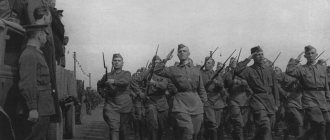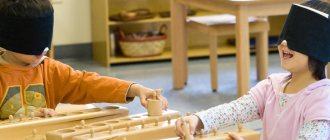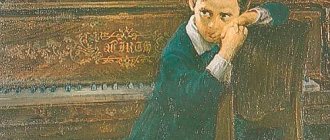Even the most tragic event can be forgotten. This is what happens with the Great Patriotic War - fewer and fewer people who went through wartime remain alive. Veterans are leaving. Facts and dates are erased from the memory of young people, and teenagers often don’t even know the basics: who fought with whom and why. But one wise front-line teacher once said: “ Children! Remember! As soon as you forget this war, immediately expect a new one! " That’s why stories about war are so important for children, and you can introduce your child to the history of a global catastrophe from a very early age.
Make sure your baby is okay while you're away. Install the “Where are my children” application to always know where your child is, what is happening around him, and how he is feeling.
Content:
- How to tell children about the Great Patriotic War Why tell children about the war
- Where to start a conversation Why the war started
- Military professions
- For preschoolers
How to tell children about the Great Patriotic War
The main advice: when discussing war, do not use words from a textbook. Children remember small details, unusual facts and features better. Tell the story of the Second World War as an event in which real people with different, albeit similar, destinies took part.
Why tell children about war?
Sometimes parents and other adults are in no hurry to tell their children about the war, fearing that the child will be traumatized by the tragedy of the story. But children perceive stories about the Second World War quite calmly; the main thing is to choose the right presentation. Every child needs to know about the Great Patriotic War: while we pass on the memory of Soviet soldiers from generation to generation, children continue to honor the feat of their grandfathers and great-grandfathers. This means that the heroes did not shed their blood in vain.
Where to start a conversation
When starting a conversation about war, of course, it is necessary to take into account the age of the child. A child under five years old is unlikely to be ready for a very serious topic. But children over five years old already have a well-developed concept of justice: at this age, the child clearly understands “what is good and what is bad,” and therefore will be able to correctly evaluate the events retold by an adult. The only thing you should avoid in conversations about the Second World War with preschoolers and primary schoolchildren is overly dramatic descriptions of the dead and wounded.
You can start a conversation about war using the example of a relative who fought. If there is no such relative, briefly describe in simple words why the war started.
Why did the war start
It is necessary to tell your child why the war started. But the story may be different for different ages. For younger children, it is enough to explain the reasons for the war in general terms: how one country wanted to seize the territories of other countries and how the leaders of different states quarreled among themselves.
Schoolchildren can be presented with a more detailed and honest version of events: that the German fascists under the leadership of Hitler - one of the most cruel people in the entire existence of mankind - decided to kill other people because these people were of a different nationality. In the conversation, it will be useful to mention that in Germany itself there were people of different nationalities who were primarily affected by fascist persecution.
How to talk about war and what to talk about
When talking about the war with children of any age, answer all the questions that young listeners have. Even if you don’t know the answer, it’s not a big deal; you can find all the necessary information in additional sources. To better understand the topic, mention in your conversation about the children who lived during the Great Patriotic War and participated in the defense of their Motherland.
What exactly to tell children about in a conversation about the Second World War - an approximate brief plan:
- the treacherous attack of fascist Germany on the Soviet Union (here it can be explained that previously Russia was not a separate country, but was part of the Union along with other republics) on June 22, 1941 at 4 a.m.;
- heroic defense of the Brest Fortress - June 22-July 20, 1941: the fortress was defended by 4,000 people;
- Battle of Moscow - October 1941-April 1942: one of the turning points of the Second World War;
- Siege of Leningrad (modern St. Petersburg) - September 8, 1941-January 27, 1944: it was possible to break through the blockade ring only after 872 days;
- Battle of Kursk - July 5-August 23: the most fierce battle of the entire war, the result of the battle was the destruction of the two main fascist groups;
- Battle of Stalingrad - July 17, 1942-February 2, 1943: after a battle that lasted 200 days, it became clear that the defeat of Germany by Soviet soldiers was a matter of time;
- capture of Berlin - April 1945: Soviet soldiers reached the German capital, simultaneously liberating other European countries captured by the Nazis;
- Victory Day - May 9, 1945: the day before, late in the evening, the final Act of unconditional surrender of Nazi Germany and its armed forces was signed.
You can talk about the main milestones of the war briefly or in more detail - depending on the age of the children. If the children are carried away by the conversation, end the conversation with questions on the topic. For example, like this:
- When did the Great Patriotic War begin?
- Which country attacked the Soviet Union?
- Who are the fascists?
- Who won the war?
- How long did the Second World War last?
- What holiday do we celebrate on May 9?
Reinforce the discussion of the war visually: show children photographs from the Great Patriotic War.
What else should you tell children about in a conversation about the Second World War - recommendations from teachers:
Military professions
Explain to the children that, in addition to the well-known and familiar professions (teacher, doctor, builder), there are also special professions - the military. A person who has chosen a military profession may be able to develop combat tactics, design military equipment, master weapons, and be able to provide first aid. Examples of military professions: sailors, pilots, signalmen, medical workers.
In a conversation about military professions, talk about how difficult it was for those who remained in the rear. Women, children, and elderly people worked almost without rest to make life easier for those who fought: they created military equipment in factories, grew food for Soviet soldiers, and sewed uniforms.
Hero Cities
Tell your child that hero city is a very honorable title, and those cities whose residents showed special heroism and courage were awarded this title. Nowadays, when the USSR no longer exists, hero cities are located on the territory of Russia, Ukraine, Belarus:
- Brest - almost all its residents took part in the defense of the city;
- Odessa - the defenders of Odessa were the first to begin a subversive war against the Nazis: they made their way into the city at night to disable equipment and blow up houses occupied by the invaders;
- Leningrad - the residents of modern St. Petersburg had a particularly hard time: the Nazis did not allow convoys with food and medicine into the city, deliberately broke the heating system, and for more than two years the residents of besieged Leningrad were malnourished and freezing, but did not surrender the city to the enemy;
- Kyiv - the city was occupied for 778 days, during which time the Germans almost completely destroyed the city;
- Sevastopol, a city near the Black Sea, Hitler planned to capture in the very first days of the war, but the city’s residents managed to hold their defense for 8 months;
- Murmansk has experienced a huge number of attacks, more than 180 thousand bombs were dropped on the city, partially destroying it. But Murmansk did not give up, its residents continued to work and defend themselves;
- Tula - from October to December the population heroically defended their hometown;
- Minsk - after three years of occupation, almost nothing was left of the city, and after the war Minsk was rebuilt;
- Novorossiysk - the city defended itself for 225 days, the battles ended with the complete liberation of Novorossiysk;
- Kerch - the city spent 700 days under occupation, its residents suffered more than others from the fascist invaders;
- Volgograd (Stalingrad) was one of Hitler’s main goals, but the Nazis failed to break through the defenses, and after 200 days the Germans themselves were captured by Soviet soldiers;
- Moscow - on the approaches to the capital of the USSR, German troops suffered their first major defeat.
Awards
Special awards were created for WWII participants, and they were presented to heroes of any rank: commanders of detachments and divisions, ordinary soldiers, doctors, child heroes. Examples of WWII awards:
- Orders of Suvorov, Kutuzov, “Red Banner”;
- medals “For Military Merit”, “For Courage”;
- awards for the defense of hero cities.
How to tell your child about Victory Day
You can awaken a child’s interest in the holiday with a simple question: “Do you know what holiday is tomorrow?” Children love holidays, and the child will probably start asking leading questions.
Usually, children first hear about Victory Day early - at 3-4 years old. Considering the age of the baby, do not drag out the story and do not overload the conversation with details. For example, a conversation can be structured like this: “When your great-grandfather was as little as you are now, our country was attacked by very evil people - the Nazis. But our soldiers managed to defend their native land and defeat the invaders, and Victory Day fell on May 9, 1945. Since then, we have celebrated this holiday every year, remembering everyone who fought for victory.”
The story can be supplemented by viewing children's themed books with large photos and images dedicated to the Second World War and Victory Day.
Life and exploits of children during the Second World War
“War does not have a woman’s face,” that’s what writer Svetlana Alexievich called her book. We can safely add that the face of war should not be childish: and in 1941, children who were barely 10 years old defended their Motherland on an equal basis with adults.
Tell your child about his peers who lost their childhood: in the lives of these boys and girls there were no fairy tales, cartoons, or even parental care. Often a child is sincerely imbued with a story when its participants turn out to be children like himself.
Boys and girls got to the front in different ways. Sometimes their parents took them with them, suggesting that staying at home was even more dangerous, sometimes soldiers picked up children lost during battles. But more often than not, the guys themselves wanted to get to the front, and simply ran away from home to the front line, and the commanders had no choice but to accept the young soldier into their ranks.
Three stories about children of the Great Patriotic War, whose courageous deeds will forever remain in the history of Russia:
Marat Kazei, 14 years old
Monument to Marat Kazei, Minsk, 1984. Photo: Antonio3.14. Source
By the beginning of the war, Marat had only completed elementary school. Even before the war, the boy’s parents were declared “enemies of the people” (then, before the war, many innocent people suffered from false accusations), only the mother was left alive. Marat’s mother forgave the Soviet authorities for the unfair accusations, and during the war she hid partisans in her home, for which she was hanged by the Nazis.
Then Marat himself joined the partisans and carried out activities on a par with his adult comrades: he blew up enemy trains, went on reconnaissance and participated in dangerous raids. A year before the Victory, Marat Kazei died, blowing up both himself and the fascists attacking him with a grenade.
Serezha Aleshkov, 6 years old
One of the youngest combatants. A little boy got lost in the forest, escaping with partisans from a village captured by the Germans, and was picked up by scouts of the 142nd Guards Regiment.
Due to his age, Seryozha did not participate in battles, but he helped in every way he could: he delivered mail and food, and brought shells. And one day a boy saved the regiment commander while clearing away the rubble of the dugout where the commander ended up. After the war, Seryozha was adopted by Major Mikhail Vorobyov, who also fought in the 142nd Guards Regiment.
Zina Portnova, 17 years old
The young partisan joined the underground organization “Young Avengers”. Zina managed to get a job as a dishwasher in a German canteen, where she poisoned the food, killing more than a hundred fascists.
In 1943, the girl was captured and brutally tortured, but she did not surrender to her family. During one of their interrogations, Zina shot three Germans with a stolen pistol. In 1944, Zina Portnova was shot without obtaining the necessary information from her.
The children who remained in the rear also performed feats - only labor ones: they worked day and night in factories to provide the army with everything they needed, sewed and knitted clothes, and made dishes.
Valentina Oseeva. "Father's Jacket"
When leaving for the front, the father passes on to his eldest son Lenka not only his black velvet jacket, but also responsibility for his mother and younger brothers and sisters. Lenka is only thirteen years old, but he is a small man. Valentina Oseeva, with piercing maternal love, describes the life of children of war, forced to replace adult front-line soldiers for the time being. Father's jacket is a symbol of an entire generation. Our great and tragic history.
9.
The best books and stories about war for children
Below are war stories for children, suitable for different ages:
For preschoolers
- E. Blaginina “Why are you saving your overcoat?”
- A. Grebenin “Vera Ivanova”.
- A. Mityaev “Letter from the front.”
For younger students
- L. Voronkova “Girl from the city.”
- V. Oseev “Vasyok Trubachev and his comrades.”
- V. Dragunsky “Watermelon Lane”.
For middle management
- V. Bogomolov “Ivan”.
- V. Rudny “Children of Captain Granin.”
- S. Alekseev “Stories about war.”
For teenagers
- A. Likhanov “The Last Cold”.
- N. Nadezhdina “Partisan Lara”.
- B. Vasiliev “Not on the lists.”
A little about books about war that children of all generations read and reread:
- A. Mityaev “Letter from the front.” The book is easy to read on your own - the author wrote for a children's audience in simple and understandable language. The plot of the book is based on real events.
- V. Oseev “Vasyok Trubachev and his comrades.” A book about an ordinary boy Vasya Trubachev and his friends, whose childhood ended with the coming war.
- V. Rudny “Children of Captain Granin.” The story of how young warriors not only defended the Gulf of Finland, but also took fire upon themselves at the decisive moment.
- B. Vasiliev “Not on the lists.” The Russian soldier fought against the Nazis for ten months, and then was captured. And then it turned out that no one even knew his name, and he forever remained an unknown hero.
Leonid Panteleev. "My heart is in pain"
A short story by Leonid Panteleev raises adult questions about grief and the loss of loved ones in war. But it can and should be read to children. The hero of the story is hiding from the mother of his deceased childhood friend. “The feeling of some kind of awkwardness and guilt that I returned, and Petka died, does not leave me all evening... My heart claws painfully: I see in my mind the whole of Russia, where in every second or third family someone did not return...”
3.
Celebrating Victory Day: crafts for May 9th with children
Options for beautiful and simple crafts for May 9:
Plasticine compositions
Using plasticine on a sheet of colored cardboard, you can depict any thematic symbols: a star, a flag, carnations, St. George's ribbon, and much more.
- Plasticine postcard for Victory Day: https://www.youtube.com/watch?v=F7cWgdlspbs
- Victory salute made of paper and plasticine: https://www.youtube.com/watch?v=fb0mnLWBRCw
Dove of peace
A simple craft that even a preschooler can do on his own. For this craft you will need: white napkins, a sheet of white or colored cardboard.
How to do it: on a sheet of cardboard, draw a composition, for example, a dove and a globe. Next: cut out squares from a white napkin, screw the squares onto a pencil and glue the image of a dove inside.
- Dove of peace using origami technique: https://www.youtube.com/watch?v=Jtg-Qzys6Uk
Other options
- Crafts made from CDs for May 9 look good. You can place any thematic composition on the shiny surface. Video instructions for making crafts from disks: https://www.youtube.com/watch?v=9TYHxGrGV68
- Volumetric tank made of boxes and paper: https://www.youtube.com/watch?v=HMhamUAlylM
- Very beautiful 3D postcard “Box with orders”: https://www.youtube.com/watch?v=uMxGudBkpMQ
Find more craft ideas for May 9 with detailed instructions and video master classes here.
It is imperative to tell children about the war. In the wake of patriotism, the topic of the Second World War comes up often, and the war is discussed quite actively with schoolchildren. But, as a rule, the facts are presented in dry language and do not carry any emotional overtones. Therefore, only parents can tell their child about a real war in which thousands of people died protecting future generations. Let your child know that they protected his future life too.
3
Arkady Gaidar. "Hike"
While Alka was sleeping, his father went to war. The boy is outraged that they didn’t wake him up. He is about to leave after his father. Alka's cunning mother unexpectedly allows him to go on a hike, but with one condition. You need to be properly prepared for a difficult road. And now she and Alka are learning marches, sewing banners, knitting stockings and mittens... Before reading this story to the little listener, it is worth mentioning that Arkady Gaidar never returned from his military campaign.
2.










